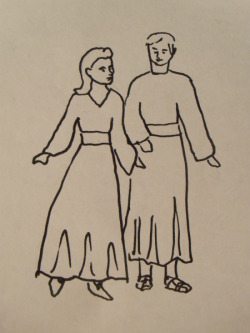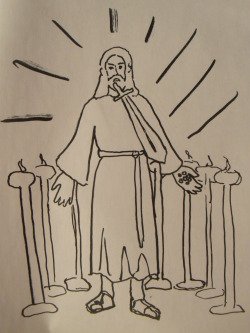Ayisha reflects on how the tenets of the New Church have yet to be fully embodied in forms of art. She ponders how these images may augment our experience of God. What are we waiting for? -Editor.
There's an idea out there that heaven is dull. In fact, I can quote someone on it: “I dunno. Heaven just always seems kinda boring to me. Like, who'd wanna go there?”
It's an understandable view, given traditional interpretations of heaven. Take a person with a Christian-ish background, who has a good work ethic and a general zest for life. If their view of heaven is an expectation that they will be sexless, living to eternity playing a harp on a cloud, with a pair of wings that excludes them from small human luxuries like tree-climbing and sleeping on their backs, then it would be no wonder if their desire for heaven were only an obedient one. They feel they ought to want to go to heaven, but they may dread it in reality.
Ah, if only they had the Heavenly Doctrines! If only they knew that angels get to do awesome, productive things, and still get to eat and sleep and make love—in fact, they are pretty much as they are on this earth, except with far keener senses and without the drudgery of taxation and living paycheck-to-paycheck.
We're so lucky to have these teachings.
Or we would be, if we were any good at picturing what we were reading. That person I quoted above is Swedenborgian. She was raised in a church society with years of worship and Sunday School under her belt. I bet she could tell me which gifts Swedenborg brought back from which heavens, so it's not as if she wasn't familiar with his narratives about heaven which are interspersed throughout the Writings.
I've no trouble picturing Biblical stories in realistic and human detail, but I have to admit that my default concept of heaven is mostly flat and insipid. It turns out that my friend and I—and other New Churchmen I've since talked to—picture heaven as the color of paper with black outlines. Everyone wears robes that have about the aesthetic of hotdog buns. A married couple looks like this, for instance:

If that's heaven, what does its God look like?
Our New Church idea of the Lord should, at its least imaginative, be of a thirty-year-old Jewish man. After all, the central tenet of our faith is that Jesus is the one and only God. But another friend said to me a few months ago, “So, you know how you typically picture God, old man with a white beard . . . ?” I don't think I ever found out where her comment was leading, because I was so taken aback. No, that's not how I ever picture God. That's the God of Farside and other comic strips, not something out of the Bible or the Writings. But I had a suspicion what she had in mind, and so I asked her, “Oh, you mean with hair like cotton stuffing and a beard that looks like it's pasted on, and pebbles in his hand that are supposed to be stars, and choking on a sword?

Yes, she said, that was just what she was picturing.
Now, these pictures are well-suited for the use they were created: Sunday School coloring. I've drawn these sorts of pictures myself when I needed a project for the three- to five-year-olds. (I also drew the above examples). Anything more detailed, and kids get frustrated—crayons are notorious for not putting the color down quite where you thought they were putting it, so thick black outlines are a must.
But why are these pictures in my grown-up head? Why is it that when I hear a sensory description of celestial beauty, these inadequate images are the first things my mind conjures up? The problem is, we don't have anything with which to replace them. Our young imaginations were able to fill in the gaps; our adult imaginations are not so flexible.
Our pictures of God and spiritual reality affect our faith. If heaven is a flat, black-outline of empty white space, it's a matter for mockery. It isn't worth striving for, and anyone who really gives it weight is being childish. A God with a cottonball beard and a sword in his mouth isn't transferable into our daily lives, and we grow estranged. We keep him in a compartment of belief that we open up at Christmas and Easter, or only as an intellectual exercise.
I challenge artists, writers, or creative types of any sort to come up with art, with stories, that truly reflect our faith. The teachings of the New Church give us sensory descriptions as well as intellectual frameworks. There are many beautiful ways to portray this abstractly, to bring it in gently or stylistically, and I wouldn't mind seeing more of that. Yet there is this huge, yawning dearth of realism. How do we make heaven and God real?
These days, when I read about Swedenborg's experiences, I allow my imagination to step past the dull idea of heaven that's my default. I sit in my bed, with the book spread open on my knees, and pause to appreciate the beauty and the story laid out before me. I'm amazed at paragraphs sandwiched between ones I'm already familiar with, full of luscious little details about the way heaven works. Trying an unfamiliar translation helps—my imagination wakes up when I read the New Century Edition—but I'm seeing this richness even in the translations of my childhood, underneath the archaic language and untranslated Latin concepts. It could be that as a writer and artist I have an easier time seeing these things, and that other people's imaginations run into more of a road block. But perhaps this is exactly the point, perhaps this is the part artists have to play in spreading God's Word. I should be sharing these beautiful things I see, this human idea of heaven, this rich place that really is the best of our world multiplied. There are many ways of sharing good and truth, and many forms of use. It's valuable to be able to explain a doctrinal concept, but grounding the reality of heaven so that those concepts have a place to live in our imaginations is also important. I hear some New Church people accuse other New Church people of being too dry and doctrinal . . . but the opposite of dry and doctrinal needn't be doctrine-less. On closer look, the doctrines are achingly beautiful, like a clear fall day, where the crispness clarifies your sight, and you see distances you thought you couldn't, and the colors catch you right in the throat with emotion. God's compassion, his continual providence, are not just concepts on a page, but his intricate relationship with every action and every atom of his creation. And that relationship isn't just something vast and all-encompassing: it's near to us and mundane, in the objects on our desks and the state of our rooms.
I have seen some really beautiful, evocative New Church art. We just need more, in greater variety and in greater depth. Human beings have this way of forming a collective visual language, and ours is collectively weak.
I've done almost no religious art myself, and I find it terribly difficult. I'm not saying we all need to be Michelangelo, or that, if our skill-level has never gone past crayons, we shouldn't even try. The truest New Church art I've seen includes the talents of a teacher who draws whimsical chalk lambs and shepherds on her blackboard, as well as a life-like painting of the Woman Clothed with the Sun tenderly cradling her pregnant belly. What I'm saying is that we should start drawing our faith in a way that is real to us, and the more we do this and share it, the more we inspire others to reflect on and express their faith. Collectively, maybe we can create a culture that has art for all ages, art that falls all over the spectrum of good and truth and use.
So where do we begin? What about some forum where we can collect and post images that ring true to us? What about at church? (I always bring a notepad to Cathedral services to capture the creative image or thought when I have it.) What about drawing with your children? What about a camera at social events, not just to record but to capture moments where we feel the presence of heaven and God? Many of us experience moments of beauty and delight that inspire us and bring us to tears; maybe we don't think of them as glimpses of heaven, or that others would be lifted up by them as well.
Whether you're an appreciator of art or a creator of it, I think there's something you can contribute to our visual consciousness, and maybe through that, to our faith.
Links to art that I would add to a forum if there was one:
This painting by Eugene Burnand shows Peter and John running to the tomb on the morning of the resurrection. The anguished hope on their faces is just what I would have felt if I were them.
Kissing the Face of God by Morgan Weistling. I like that Jesus looks like a real baby.
The Annunciation, by 19th century Philadelphian artist, Henry Ossawa Tanner. Of course, the angel isn't really visible. I'd love to draw angels that looked like people but would still be recognizably angelic.